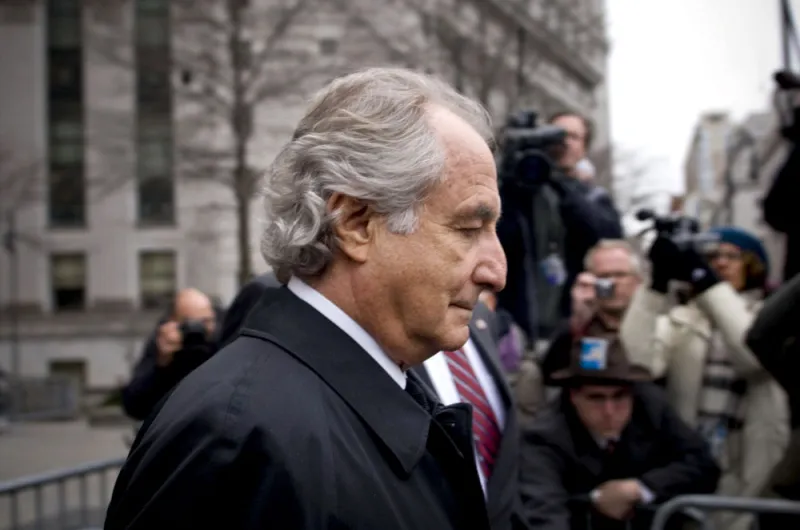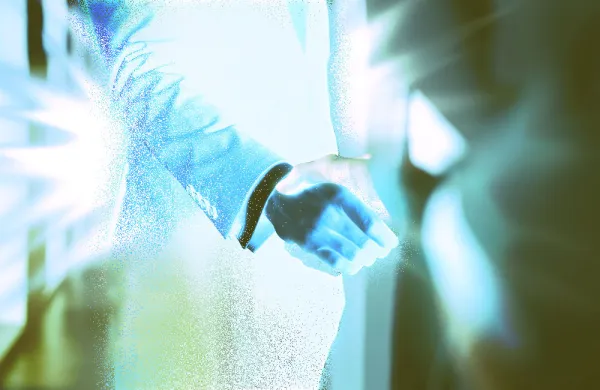
Bernard Madoff, in 2009 leaving federal court in New York.
(Jin Lee/Bloomberg)
On December 11, 2008, Bernie Madoff was arrested and charged for orchestrating a multi-billion dollar Ponzi scheme through his eponymous investment firm.
The same day, Aksia founder Jim Vos and the firm’s then-head of advisory services, Jake Walthour, sent a letter to their clients: They had predicted this.
Over a year prior, in August 2007, Aksia, the alternative investment research and advisory firm, had issued a report to clients warning them of numerous red flags regarding Madoff.
This past Wednesday, in the wake of Madoff’s death, a flurry of obituaries and retrospectives reported on how his Ponzi scheme changed the securities industry — and how it took regulators by surprise.
But some, including Aksia, weren’t shocked when the fraud was exposed. In fact, they had been expecting it to come to light for years.
In 2001, more than a dozen sources told MARHedge, a newsletter that was acquired by Euromoney Institutional Investor in 2006, that they were skeptical of Madoff’s positive, consistent returns.
It wasn't that the returns were too high, exactly. Instead, they told reporter Michael Ocrant that the volatility for these investments was lower than it should have been.
“They noted that others who use or have used the strategy — described as buying a basket of stocks closely correlated to an index, while concurrently selling out-of-the-money call options on the index and buying out-of-the-money put options on the index — are known to have had nowhere near the same degree of success,” according to that story.
Madoff told MARHedge that the firm had “no leverage, and has more than enough capital to support its operations.”
During the same time frame — from 2001 through 2008 — Harry Markopolos, a portfolio manager who had researched Madoff’s funds, reported the investment firm to the Securities and Exchange Commission five times, according to his testimony to Congress in the wake of the 2008 financial crisis.
And then there was Aksia.
Madoff Securities accepted both direct investments and worked with feeder funds, which funneled their clients’ capital into the brokerage firm. The feeder funds were one reason Madoff Securities got so big in the first place: the firm didn’t charge fees, instead making money on trading commissions.
“With basically no costs versus their fees, the feeder funds could pay very big rebates or retrocessions to fund distributors and private banks,” Vos says by phone in a recent interview.
Madoff’s funds were posting strong performance and reporting little volatility. The firm purported to use a split-strike conversion strategy, but investors who tried to replicate Madoff’s returns and low volatility were unsuccessful.
As Aksia noted in its 2007 report, a prevailing theory was that “the superficial details of the trading strategy are not true, but there is some consistent edge/strategy Madoff has.”
“The challenge with Madoff feeder funds was that if an investor is sitting there earning 12 percent per year, it’s hard to stop them,” Vos now says. “That is why we did so much digging: We had to use solid facts to scare our clients out.”
So Vos and his team started to investigate. They met in person with several former Madoff Securities traders, hired a private investigator, and talked to Madoff himself.
“There was no money machine that could pay these returns,” Vos says.
From the interviews with Madoff’s traders, Aksia learned that the balance sheet for proprietary trading at the firm was “not anywhere near big enough to pay the returns of all the feeder funds,” Vos says. They also learned that the proprietary trading business was barely profitable and that the family members working at the firm were secretive.
Soon after, Madoff called Vos one morning at 9:00 a.m., complaining that Vos had been talking to his ex-employees.
“He goes on for nearly an hour rambling about backup electricity, [convertible arbitrage] in the 1980s, and non-markets gibberish,” Vos recalls. He turned the call on speakerphone so Simon Fludgate, Aksia’s now-head of operational due diligence who was in the office with him, could hear.
Fludgate held up a note: “Ask him about the financials.”
Eventually, they came to an agreement: Madoff sent the firm’s balance sheet via U.S. Mail, despite the fact that their offices were nearby. The numbers arrived on black, stiff paper with gold lettering, almost like a menu, Vos remembers.
It was time to go undercover.
The investigator revealed that Friehling and Horwitz had one active accountant who, when Aksia called him pretending to be a prospective client, hung up immediately. The other partner was a 78-year-old man living in Florida.
The firm’s 2007 report said that Aksia strongly suspected that Madoff’s fund was “for all practical purposes not audited.”
Armed with this information, Aksia released that report in August 2007, over a year before Madoff was turned in. The report laid out four possible scenarios, ranging from Madoff’s work being completely above board to it being a fraud.
In the fraud scenario, Madoff’s mailed confirmations, “sham auditor,” “internal secrecy, and family members in key control positions,” could have been “designed to perpetuate the feeder’s existence and AUM,” the report said.
But it also pointed out a problem with that scenario: “How could anyone fool so many people for such a long time, including presumably the NASD and SEC?”
In December 2008, he finally admitted to his family that he was struggling to meet client requests for redemptions, saying that the business was “all just one big lie,” according to court filings. Madoff also said that he planned to return the remaining capital to select employees, friends, and family members before shutting down.
His sons reported the scheme to regulators. Soon after, Madoff was charged.
Prosecutors estimated in July 2009 that more than 15,400 investors lost $64.8 billion in paper wealth as a result of the fraud. As of March 2021, $14.4 billion of that had been recovered.
In 2009, Madoff pleaded guilty to eleven felony charges, including securities fraud, investment adviser fraud, mail fraud, wire fraud, three counts of money laundering, false statements, perjury, false filings with the United States Securities and Exchange Commission, and theft from an employee benefit plan. Soon after the plea, he was sentenced to 150 years in prison.
“Bernie, up until his death, lived with guilt and remorse for his crimes,” Madoff’s lawyer, Brandon Sample, said via email on Wednesday.
“In the center you had swindlers, and in the outer ring you had lots of victims,” he says. “But in between was a grey area of people who indirectly profited from the Ponzi scheme in one way or another.”
Some, he added, were honest and clueless, but he believes others knew and stuck around so they could make money.
He adds: “I still find myself thinking about individuals we met in 2007 and debating in my head their innocence or not.”





